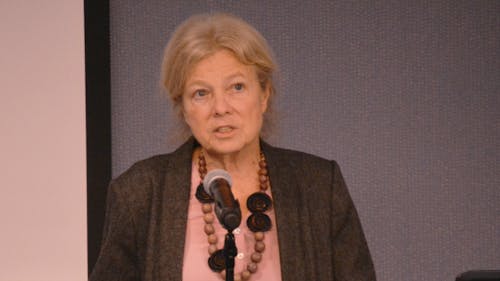50 years after graduating from Rutgers, esteemed artist pays visit to Douglass campus

On Wednesday night, artist and Rutgers alumna Alice Aycock visited Douglass campus to speak about her work and the University.
Aycock — a sculptor and installation artist — was an early artist in the land art movement in the 1970s and has created many large-scale metal sculptures around the world. The land art movement is also known as Earth art — where landscape and the work of art are inextricably linked.
Aycock said her drawings and sculptures of architectural and mechanical fantasies combine logic and imagination.
The event, welcomed by Jacquelyn Litt, dean of Douglass Residential College, is part of America Converges Here, a series of events at Rutgers University—New Brunswick that explores the unique coming together of people.
Aycock received her bachelor’s in arts degree from Douglass College in 1968.
“Douglass College is so important to me and it changed my life,” she said.
Litt introduced Aycock to the classroom of students and adults at the Kathleen W. Ludwig Global Village Learning Center. The building is a new addition to Douglass campus that is dedicated to women and global issues.
“We are thrilled to have our esteemed alumni here tonight,” she said. ”I am very pleased to say she is a graduate of Douglass.”
Litt said her pieces combined architectural and mechanical fantasies, blend logic and imagination and intermingle science and faith.
“We are almost finished restoring one of her pieces, which is very close to the original design,” Litt said.
The piece is called The Miraculating Machine.
“I like making images that force people to question why they’re there. They don’t look exactly like art installations, they look like they’re there for a reason,” Aycock said.
A lot of her art installations and sculptures are huge and built into the landscape. She has to work with a team of engineers to create some of her pieces.
She said many of the artists got their start at 112 Greene Street, an artist-run gallery in SoHo in the 1960s.
“We all worked for each other. It wasn’t the art world you know today,” she said. “There was no commerciality.”
Aycock said her early work prefaced what she does now. Her modern work deals in turbulence, interference and wave motion.
“I wanted to really deal with the transitory nature of things. Causality and chance and how they relate to each other. I thought a lot about gravity and then stepping away, letting chance take over,” she said about her early works.
Aycock said she likes to make art not just about feeling good but about uncertainty, and the unpredictability of the world.
Sometimes Aycock’s work is celebrated and becomes part of the landscape. Her "Park Avenue" series resembled giant paper sculptures. According to a New York Times article, people have said it broke up the city streets.
Other times, her work is not so well received. Aycock described a piece she did on the roof of the 107th Police Precinct House in Flushing, Queens. It resembled a giant satellite dish.
“I think some people thought it was a huge surveillance device and that the government was spying on them,” she said.
The sculpture was meant to symbolize communication between the police and the community, she said.
“I want you to say, ‘What is that?’” Aycock said. “I want you to have a dialog with the world and have a visual experience. It doesn’t have to be art to you, it has to start a conversation.”
Some of her work resembles amusement park rides, but Aycock said she used to be embarrassed because she was inspired by amusement parks, but they continue to be a source she uses.
Her team of engineers sometimes use computer programs to make her designs, as her work pulls further and further away from studio art.
Aycock ended her presentation about a story of a girl from her time in India. She said she just wanted to admire a building when she felt a tug on her dress. After resisting, Aycock turned to see a girl begging and noticed a huge scar.
“That was all she had,” she said. “I was standing here and admiring this beautiful building and that scar was all that girl had.”
Aycock explained she took a taxi right home and made a drawing of the girl.
“My drawing won’t change her life, but it’s the one thing I can do as an artist," Aycock said. "I can put something out there for her that didn’t exist. If I can so that for her, then I will be happy."
Jillian Pastor is a contributing writer for The Daily Targum.



